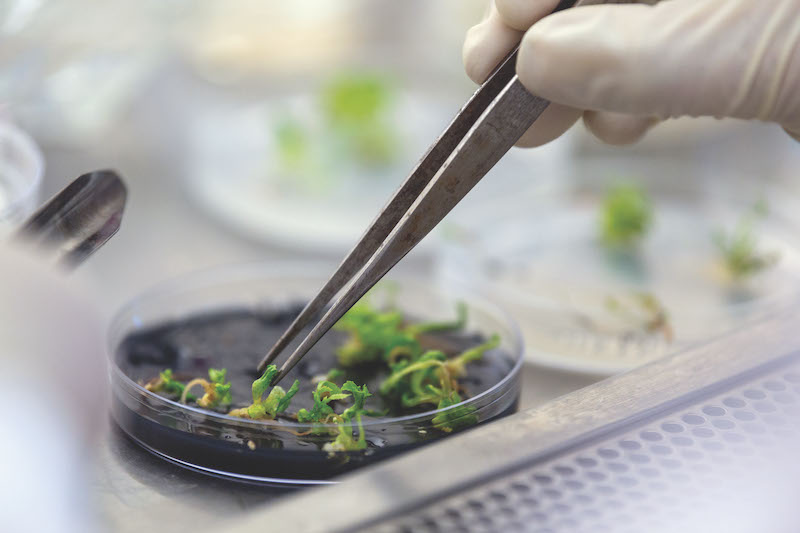Anthony Farone total grant funding: $7.1 million
Inspired by Jacques Cousteau’s aquatic adventures and other PBS nature shows on the four TV channels he watched in childhood, Anthony “Tony” Farone wanted to become a wildlife or outdoor biologist one day. But, as his interest and knowledge in the subject advanced during high school and college in Pennsylvania, he noticed how much cancer was affecting the extended family of his parents, who grew up during the Depression era.
“I realized that there were a lot of these older folks in our family who were getting cancer and dying of cancer,” the MTSU Biology research professor said, “and it kind of switched my biology focus to where I am now with a more medically related emphasis.”

Anthony “Tony” Farone, MTSU Biology professor and researcher, with his model train set at his Murfreesboro home (Photo by Andy Heidt)
While most of his cousins worked at steel mills or in factories and wondered when he would get a real job—“they couldn’t get over that I was still in school”—Farone not only was one of the few in his family to attend college, but also continued on to grad school and a Ph.D.
“When I was in college at Penn State, my mother’s brother had pancreatic cancer and he was very sick, and he thought that I could find a cure for him by the time I finished this graduate school thing. Whenever I would see him, home from college, he always would tell me to hurry up,” Farone recalled. “Obviously, President Biden still has this cancer moonshot, all those sorts of things, so it’s a complicated problem. It’s been interesting to learn about, and obviously I spent a lot of years on it.”
That included three years of postdoctoral research in the esteemed labs at Harvard University after completing his master’s and doctoral degrees at Miami University in Ohio, where he and wife Mary, also an MTSU Biology professor, “met under a microscope.”
“We’ve worked together pretty much ever since,” Farone said.
The couple had never heard of MTSU until he saw a faculty position open up, and they decided to move south with their baby in 1995. Tony Farone’s career at MTSU, as well as his wife’s as she wended her own way, have followed the arc of the growth of the science and research programs—and certainly played a role in that trajectory as well.
They also underwent their own personal journey with cancer when that baby, Grace, the oldest of their four children, was diagnosed with a sarcoma as a high school freshman.
DISCOVERY OF A NEW GENUS
Before relocating for Tony’s faculty job—and closer proximity to Mary’s family in Kentucky—the Farones both had promising research careers with Harvard post-doc fellowships.
“That pretty much is as good as it gets research-wise,” he said about his Harvard days. “But I had always enjoyed working with undergraduates and other students.”
When accepting the faculty position, Tony Farone had been guaranteed a mobile home-type facility to use mice in his laboratory work as part of a grant proposal both Farones had written—perhaps the first National Institutes of Health application at MTSU. He had started immunotherapy work during his doctoral program, using reovirus and low-dose chemotherapy to stimulate the immune response to leukemia in mice.
The planned portable animal facility was scrapped due to cost, however, so Farone pivoted to in vitro research since the couple had already bought a house. His wife soon joined him on campus and shared a small office with him, taking over a counter in his space closer to the lab than her first office—until the 250,000-square-foot Science Building opened in 2014.
FARONE’S CAREER AT MTSU . . . FOLLOWED THE ARC OF THE GROWTH OF THE SCIENCE AND RESEARCH PROGRAMS—AND CERTAINLY PLAYED A ROLE IN THAT TRAJECTORY.
Along the way, as Tony worked on major grant projects, often in partnership with Mary as well as other researchers, the University added three science Ph.D. programs including the Molecular Biosciences doctorate. MTSU also achieved the recent R2 designation (high research activity) and constructed the state-of-the-art Science Building, where the couple now has adjacent quarters. That new building was supposedly nearing reality when Tony Farone was hired, but the Molecular Biosciences doctorate helped put the project back on the drawing board.
“We really planned the building like three different times,” he said.

Farone’s research, focusing on the interaction between the immune system and pathogens, now helps support Ph.D. students in that program and is attached to MTSU’s Tennessee Center for Botanical Medicine Research. The interdisciplinary center works to develop drugs from botanicals and natural compounds that have anti-cancer, anti-viral, anti-parasitic, and anti-inflammatory activity to help combat conditions such as cancer, diabetes, rheumatoid arthritis, and Crohn’s disease. Farone has received three patents in his quest to invent new immunotherapeutics.
One of Tony’s (and Mary’s) big breakthroughs, in 2015, was actually part of a major Environmental Protection Agency-funded project in the wake of the famous Legionnaires’ disease outbreak in a Philadelphia hotel in 1976. As one of their first grants, he started working with MTSU researcher Anthony Newsome since Legionella pneumophilia usually affects lung macrophages, a type of immune cells and Tony’s area of expertise, and he had Mary help revise that grant written by Newsome and Tennessee Technological University colleagues. Prior to her joining the MTSU faculty full time, he then brought Mary aboard as a technician to help collect water samples on a second grant project, where they were looking for the prevalence of the organism in natural environments versus constructed environments.
In 2015 the team discovered a new genus of bacteria taken from samples collected years before. Two new species were identified in the MTSU lab, named Candidatus Berkiella aquae and Candidatus Berkiella cookevillensis after research partner Sharon Berk and Cookeville, where they were found in a cooling tower and a hot tub.
“That was my role to find them, and then his role was to see if they infected human macrophages,” said Mary Farone, whose expertise is in viruses—Legionella bacteria infect cells similarly to viruses.
One of the samples collected by the Tech team indeed did so—and, in fact, infected the nucleus, which was extremely unusual, and replicated.
“We had isolated these samples in 1999, and it wasn’t until really just recently that we were able to identify this new genus of bacteria—like those Jacques Cousteau kind of documentaries that we used to watch growing up where you would find this whole new kind of sea life at the bottom of the ocean,” Tony Farone said. “. . . It’s really that different of a bacteria.”
It was a monumental discovery at MTSU, one in which University researchers—and around a dozen students—played a prominent role. They hope genetic assessments may lead to how it’s getting into the nucleus and thereby figure out how to take a treatment inside a cancer cell.
POWERFUL AGENTS, POWERLESS PARENTS
An outgoing guy, Tony Farone also made other connections early on that boosted his research—and that of MTSU’s Biology Department. For one, he reached out to a Vanderbilt virologist, attended that researcher’s lab group meetings, and collabo-rated on a couple of projects together.
On another of his grant projects, the $3 million GK–12 National Science Foundation award from 2009 to 2016, Farone made connections with class-room teachers, industry partners, and Chilean and Puerto Rican universities and students. That project involved educational rather than lab research.

Anthony and Mary Farone with granddaughter Emma, whose mom Grace earned a Dietetics degree from MTSU (Photo by Andy Heidt)
“I think I was in every office on campus that related to money or contracts, budget, auditing—oh, man, it was complicated,” Farone said. “My mom’s penmanship was perfect, and she was so disap-pointed that I had signed my name so many times that it just became a squiggle.”
While his laboratory work and grants regularly support stipends for doctoral as well as master’s and undergraduate students, this project provided around $30,000 apiece for 30 grad students to conduct research and teach in area high schools. He also had to persuade other MTSU faculty to part with researchers to work on the project.
During this period a decade ago, a tumor developed on then-teenage daughter Grace’s hand. It was a heartbreaking and helpless time for the two scientist parents. The Farones couldn’t believe how toxic chemotherapy agents still were—treatments more than 50 years old. Although Tony had continued along that research path some, he had steered more toward infectious agents after arriving at MTSU and having to take a detour without his lab mice. Even powerhouses in the field had been unable to affect the available treatments for Grace, and the research couple felt powerless.
“She came out of it really well thanks to Vanderbilt and the children’s hospital. That was probably the roughest situation we had to go through,” Tony Farone said.
“I always tell the story to my students that we both lost our hair, but hers came back.”
WORKING AROUND THE TABLE
Grace went on to graduate from MTSU’s Dietetics program, became a dietitian at Vanderbilt University Medical Center, and now has a daughter of her own.
For a family who hadn’t heard of MTSU, they’re almost totally True Blue now. Second daughter Cate received a Buchanan Fellowship before earning her bachelor’s at MTSU and now studies law at Belmont, while oldest son Danny is a Data Science major who recently served an internship at the University’s Data Science Institute. The youngest, Dominic, a high school senior, may be headed to campus to pursue a Chemistry or Biochemistry degree.

“I’m just blown away by how good our faculty is,” Mary said.
The Farones couldn’t help but bring work home, discussing students and research over the dinner table, although they tried to limit it when the children were younger. And they often worked after the kids went to bed, with Mary especially turning into a night owl and Tony taking the morning shift to get the children to school.
WE WERE ABLE TO IDENTIFY THIS NEW GENUS OF BACTERIA—LIKE THOSE JACQUES COUSTEAU KIND OF DOCUMENTARIES . . . WHERE YOU WOULD FIND THIS WHOLE NEW KIND OF SEA LIFE.
Family is obviously important to Tony Farone, an only child whose 94-year-old mother has lived with them since the early 2000s and helped with the children and the cooking as a “support system behind the scenes.” Inspired by his southern Italian heritage and his mother’s dishes, Tony often cooks meals for the family, with Grace and his first grandchild, Emma, who live next door, joining them when his son-in-law works nursing shifts.
Farone also helped with his children’s scouting activities, including serving as a Cub Scout leader. And his passion for model trains, kindled as a kid after inheriting a family train set, has been handed down to the next generation and, soon, to the newest one.
“It went into storage for about 20 years until we moved to our current home in Murfreesboro that also has a basement,” he said. “We set up my current Polar Express layout with my four kids as they grew up, during the break between fall and spring semesters. Now, my granddaughter and I get to enjoy it together.”
And that’s what he values—family time—whether it’s working with his wife in the lab to find a cure, cooking up meals, or turning on the train track.

COMMENTS ARE OFF THIS POST